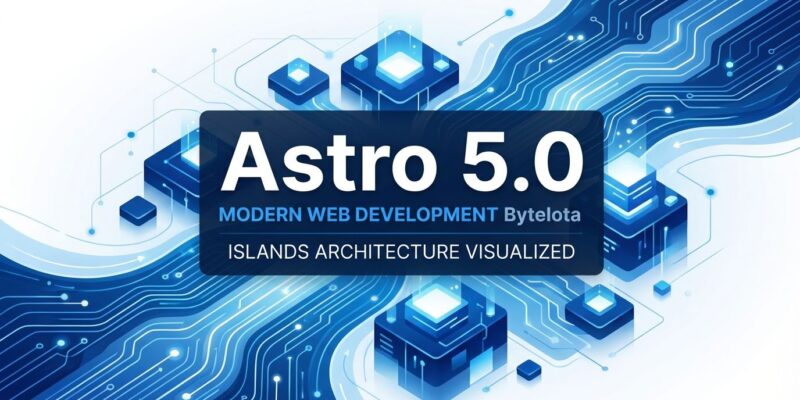
Astro 5.0 just dropped, and it’s bringing the zero-JavaScript revolution to the mainstream. The latest release introduces the Content Layer API and Server Islands—two features that prove the islands architecture approach isn’t just theoretical anymore. While React and Next.js are adding complexity to achieve similar performance, Astro is making it the default. For developers tired of shipping megabytes of JavaScript for essentially static content, this is the framework update you’ve been waiting for.
Server Islands: The Static-Dynamic Holy Grail
Here’s the perennial web development problem: you want blazing-fast static content for performance, but you also need dynamic, personalized components. Traditional solutions force you to choose one or sacrifice the other.
Server Islands solve this by letting you combine high-performance static HTML with dynamic server-generated components on the same page. The framework defers rendering of dynamic content until after the initial page load, so your core content loads instantly while personalized elements—user avatars, shopping carts, product reviews—populate seamlessly afterward.
This isn’t just clever engineering. It’s a fundamental shift in how we think about building performant, personalized web experiences. You get the cacheability and speed of static content with the flexibility of dynamic rendering, no compromises required.
Content Layer API: Load From Anywhere, Build Faster
The Content Layer API introduces a unified, type-safe way to load content from any source. Whether you’re pulling from local markdown files, a headless CMS like Storyblok or Hygraph, or a custom API, the interface stays consistent.
The real win? Performance. Content-heavy sites building Markdown pages see 5x faster builds. MDX gets 2x faster, while memory usage drops 25-50%. For teams managing hundreds of pages, these aren’t marginal improvements—they’re workflow changers.
Better still, Astro maintained backwards compatibility. Legacy content collections continue working alongside the new system, meaning you can upgrade now and migrate content sources on your own timeline. It’s a rare example of getting both innovation and stability.
The Numbers Don’t Lie
Astro claims 40% faster load times and 90% less JavaScript compared to popular React frameworks. Impressive on paper, but what about reality?
A documented WordPress-to-Astro migration tells the story. Largest Contentful Paint dropped from 0.81 seconds to 0.44 seconds—a 46% improvement. Time To First Byte improved 18%. Resource efficiency showed 72% less HTML, 60% less JavaScript, and 90% less CSS delivered to browsers.
Build times reveal another advantage. One 40-page site migrating from Gatsby saw builds drop from 2 minutes 45 seconds to under 50 seconds. That’s the difference between quick iteration and getting coffee during every build.
Migration Myths vs. Reality
Framework migrations have a reputation for pain. Astro 5.0 challenges that assumption. Most projects complete migration in 1-3 weeks, with larger teams taking 2-4 months for complex applications. Developers familiar with React or Vue report learning Astro basics in 2-3 days.
The migration documentation includes a telling line: “After upgrading Astro, you may not need to make any changes to your project at all.” That confidence comes from deliberate backwards compatibility. While there are breaking changes—script handling works differently, some token names changed—the framework doesn’t force wholesale rewrites.
Performance improvements appear immediately. Teams report seeing faster loads and smaller bundles from the first migrated pages, providing instant validation that the effort is worthwhile.
React Plays Catch-Up
It’s worth noting the broader context. React 19 is adding Selective Hydration. Next.js now offers Partial Pre-rendering. These are responses to what Astro and similar frameworks pioneered with islands architecture.
The difference? Astro makes performance the default. React-based solutions require careful orchestration, understanding when to use Server Components, when to hydrate, how to structure your component tree. Astro ships zero JavaScript unless you explicitly add it. The burden of proof reverses: instead of optimizing to remove bloat, you start lean and add interactivity only where needed.
This isn’t anti-React sentiment. React revolutionized component-based development. But for content-focused sites—blogs, documentation, marketing pages, news sites—the “React for everything” approach carries unnecessary weight. Astro 5.0 makes that abundantly clear.
Should You Care?
If you’re building a highly interactive application with dynamic state throughout, Astro might not be your tool. But if your site is primarily content with pockets of interactivity? Pay attention.
The framework now offers production-ready solutions for combining static performance with dynamic personalization. The Content Layer API provides real flexibility in how you source content. Migration paths are smoother than expected, and performance gains are immediate and measurable.
How much JavaScript does your blog really need? If the answer is “less than we’re currently shipping,” Astro 5.0 deserves a serious look.











